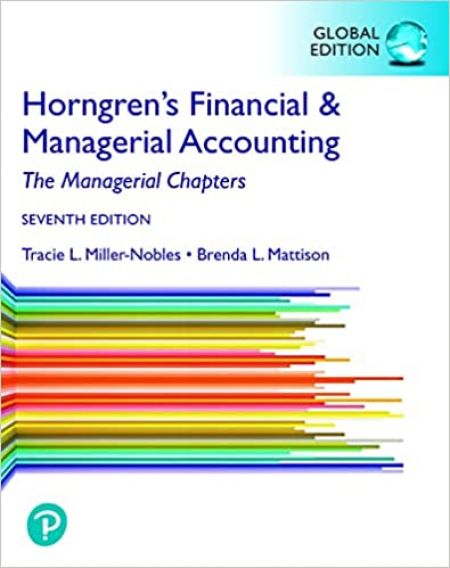Nostro prezzo € 104,50 € 110,00 -5.00%
Disponibilità: Ordinabile in 10-15 giorni lavorativi
Quantità
Descrizione
Acquisto di GRUPPO?? Se volete risparmiare
contattateci!
Autore: Horngren, Miller-Nobles, Brenda Mattison, Ella Mae Matsumura
Editore: Pearson - Prentice Hall
Data di Pubblicazione: 2023
ISBN: 9781292420899
Pagine: 964
Horngren's Financial and Managerial Accounting, The Managerial Chapters presents the core content of principles of accounting courses in a fresh format designed to help today's learners succeed. As teachers first, the author team knows the importance of delivering a student experience free of obstacles. Their pedagogy and content uses leading methods in teaching students critical foundational and emerging topics (e.g., data analytics and employability skills) in the field of accounting, and concentrates on improving student results - all tested in class by the authors themselves. With this in mind, the 7th Edition continues to focus on readability and student comprehension and takes this a step further by employing a new theme to help students see how accounting is used as a tool to help businesses make decisions. By providing more meaningful learning tools, this title gives professors the resources needed to help students clear hurdles inside and outside of the classroom, like never before.
Features
-
Chapter Openers present relatable stories that set up the concepts to be covered in the chapter. Students then learn the implications of those concepts on a company's reporting and decision-making processes.
-
Common Questions, Answered is rooted in the authors' teaching experiences over the years, and offers additional help with patterns and rules that consistently confuse students. Located in the text's margin next to where the answer or clarification can be found, they help students better understand difficult concepts.
-
Instructor Tips & Tricks throughout the text mimic the experience of having an experienced teacher walk a student through concepts on the board. Many include mnemonic devices or examples to help students remember the rules of accounting.
-
Effects on the Accounting Equation illustrations help students see connections between transactions, as well as how transactions fit into the bigger picture. Located next to every journal entry, they reinforce the connections between recording a transaction and the effect those transactions have on the accounting equation.
-
Try It! boxes found after each learning objective and at the end of the chapter give students the opportunity to apply the concepts they've just learned by completing an accounting problem.
-
Things You Should Know provide students with a brief review of each learning objective presented in a question and answer format, helping to prepare them for exams.
-
Decisions Boxes highlight common questions that business owners face, prompting students to determine the course of action they would take based on concepts covered in the chapter.
-
Comprehensive Problems, located in select interrelated chapters, help students make connections between topics.
-
Chapters 1-5 discusses fundamental managerial accounting concepts: job ordering, process costing, cost management systems, and cost-volume-profit analysis.
-
Chapters 7-9 explores planning and control decisions for a manufacturing company, including a master budget, flexible budget, variance analysis, and performance evaluation.
-
Chapters 10-11 reviews decision making, both short-term business decisions and capital budgeting decisions
New to this edition
-
Data and research, including any years and numbers as they relate to real companies (such as Kohl's and Target), ensures students have relevant examples to help them engage with the course.
-
Discussions of important concepts and calculations help students to better understand the material. They include:
-
Chapter 1 'Introduction to Managerial Accounting' offers updated info on the IMA Statement of Ethical Professional Practices to reflect changes made by IMA on July 1, 2017.
-
Chapter 2 'Job Order Costing' has a new Learning Objective for calculating Cost of Goods Manufactured and Cost of Goods Sold for easier teaching, learning, and assessment activities.
-
Chapter 8 'Flexible Budgets and Standard Cost Systems' includes updated direct materials calculations (i.e., cost vs. efficiency variance), so that inputs do not equal outputs.
-
Employability coverage throughout the text looks at professional certifications that management accountants can obtain, such as Certified Management Accountant (CMA) and Chartered Global Management Accountant (CGMA), and highlights the importance of these credentials in today's job market.
-
Data Analytics in Accounting features highlight real companies that are now using data analytics to track inventory, monitor cash flow, forecast sales, and maximise profits. Also discussed are advances in technology, including robotic process automation and artificial intelligence, and how they relate to the work management accountants perform.
-
Key Terms focus on the concepts central to students' learning, including Lean Management System, Relevant and Irrelevant Revenue, and more.
-
Check Your Understanding boxes let students gauge their comprehension of the material and have been updated to include new accounts introduced under the Revenue Recognition Standard.
-
Tying It All Together boxes tie together key concepts from the chapter using the company highlighted in the chapter opener. The in-chapter box presents scenarios and questions that the company could face and focuses on the decision-making process. The end-of-chapter business case helps students synthesise the concepts of the chapter and reinforce critical thinking. Updates to the 7th edition includes discussion of how companies are using zero-based budgeting (chapter 7).
-
End-of-chapter problems and exercises help students build skills to analyse and interpret information and apply reasoning and logic to new or unfamiliar ideas and situations. Updates include:
-
an exercise on the triple bottom line (chapter 1).
-
an exercise on completing job cost sheets (chapter 2).
-
updated labor costs to $10 per hour (chapter 8).

